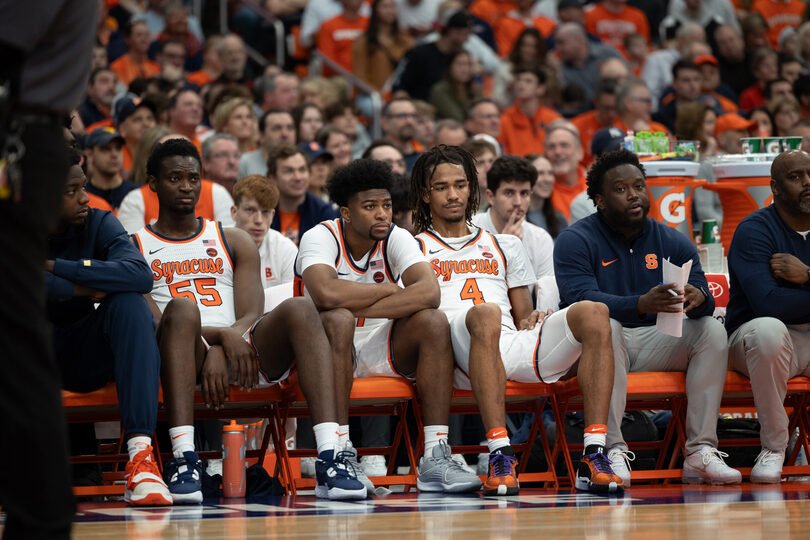Syracuse’s depth issues bring foul troubles, more zone defense

Ryan Jermyn | Staff Photographer
After Syracuse suffered multiple season-ending injuries and dismissed Benny Williams, it’s faced limited depth.
Get the latest Syracuse news delivered right to your inbox. Subscribe to our sports newsletter here.
During Syracuse’s media day in October, head coach Adrian Autry preached his team’s depth. He knew SU — at the time — had versatility on both ends of the ball, and Autry said he would play more than six or seven guys, a trend away from his predecessor, Jim Boeheim.
Months later, Autry’s now facing the situation he once hoped to avoid. Season-ending injuries to Chance Westry and Naheem McLeod, the dismissal of Benny Williams and the day-to-day status of Peter Carey following his concussion have stripped the Orange of their depth. Now, Syracuse (17-10, 8-8 Atlantic Coast Conference) is seeing the effects of its limited lineup with more use of the 2-3 zone and adjusting to foul trouble.
“It’s different,” Justin Taylor said of playing six or seven players after SU’s loss to Clemson on Feb. 10. “Losing Naheem (McLeod) definitely hurt. It’s our job just to be better conditioned. Be ready to go all 40 minutes and try not to get tired obviously. It’s hard when you’re going up and down like that.”
In three consecutive games versus Louisville, Clemson and UNC from Feb. 7-13, Syracuse only played seven players — Mounir Hima and Carey, who’s been out since the Clemson game, played less than six minutes in each game. In SU’s most recent two games versus Georgia Tech and NC State, Autry played eight and similarly, Hima played six minutes or less.
The last time Syracuse played with nine players or more was against Wake Forest on Feb. 3, when it lost by 29. It marked Williams’ final game and Kyle Cuffe Jr. ‘s last appearance before returning two weeks later in SU’s loss at Georgia Tech on Feb. 17.

Cole Ross | Digital Design Editor
Autry said on Feb. 10 that it was a “coach’s decision” not to play Williams versus Louisville and Clemson. At the weekly ACC coaches call on Feb. 12, Autry said it was “always the plan” to get Cuffe Jr. back on the floor. The decision not to play him put more responsibility on the backcourt duo of Judah Mintz and J.J. Starling.
“We need it,” Autry said of playing Cuffe Jr. “We’re down on bodies and these guys are logging a lot of minutes. As we get toward this final stretch, I want guys as fresh as possible, so I will definitely have to get him in there.”
As for the frontcourt, Autry wants to stick with Carey and McLeod, while maintaining Will Patterson’s redshirt and trusting Hima. It puts more faith in Maliq Brown to stay out of foul trouble, subsequently changing the Orange’s defensive scheme in recent outings.
More noticeably in SU’s down to the wire win over Louisville and upset over then-No. 7 UNC, Syracuse deployed the zone, playing just seven players.
Autry said the Louisville game on Feb. 7 was the first time the Orange played that much zone, and felt it wasn’t as up to “par” as it could’ve been. Autry said the Cardinals were a strong team inside, and he, Quadir Copeland and Starling said they wanted them to shoot from the perimeter.
It was similar to the win over the Tar Heels six days later, when Syracuse used zone often and Autry said it was the factor that pulled off the upset. UNC often tried to get Armando Bacot in the post against Brown, but would elect to kick it out for 3 because of strong post defense. UNC made 12 3-pointers, but forcing the ball out reduced inside shots, potential fouls and allowed Syracuse to play with both Brown and Copeland on the floor.
In the Jan. 13 meeting, when UNC handed Syracuse — using mostly man defense — its worst-ever ACC loss, the Tar Heels scored a season-high 58 points in the paint. In the rematch, Autry elected to keep Syracuse in the zone and UNC scored just 32 points in the paint. Copeland forced two UNC turnovers on the perimeter in the set with less than a minute remaining.
“Our numbers are down a little bit,” Autry said postgame. “We can’t afford for Maliq (Brown) and these guys to get into foul trouble. Typically, we play man-to-man and we try to be aggressive. Against Carolina, obviously their size inside the first game, they really took it to us the first time. So I thought the zone was the best way to go this second time.”

Cole Ross | Digital Design Editor
Against Georgia Tech, an opponent that Syracuse used zone significantly against, Brown fouled out, forcing Hima to check in for less than a minute. Similarly, Copeland fouled out but the Yellow Jackets had sealed the win by then.
GT head coach Damon Stoudamire said his team didn’t do “a great job at times” against the zone. They were limited to 65 points, while Syracuse notched 12 steals and forced 17 turnovers, but failed to back it up offensively.
Autry said he chose to use zone to avoid players picking up too many fouls, but noted the Yellow Jackets’ spacing and ability to attack the gaps. It’s an adjustment he knows his team has to make approaching the final stretch of the regular season.
“Zone is just something we’re going to have to play just because of our numbers,” Autry said following the game against Georgia Tech. “Our man-to-man, we can’t be as aggressive as we were in the beginning of the year with our numbers down.”





